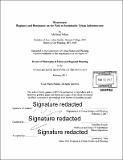Wasteways : regimes and resistance on the path to sustainable urban infrastructure
Author(s)
Pollans, Lily Baum
DownloadFull printable version (26.90Mb)
Alternative title
Waste Ways : regimes and resistance on the path to sustainable urban infrastructure
Regimes and resistance on the path to sustainable urban infrastructure
Other Contributors
Massachusetts Institute of Technology. Department of Urban Studies and Planning.
Advisor
Eran Ben-Joseph.
Terms of use
Metadata
Show full item recordAbstract
For many people, recycling is a habitual environmental action. In recent years, however, critics have shown that municipal recycling programs are not always environmentally beneficial. Municipal waste management programs are, nevertheless, a key lever through which cities can influence material consumption, which is a driver of ecological overshoot and greenhouse gas emissions. Through transformation of municipal waste management, including and beyond the adoption of expanded recycling programs, cities can potentially reduce their environmental footprints. In the U.S., some cities seem to have been able to do this, and while most have not. This dissertation asks why. Specifically, I ask if Seattle, a city known for its progressive waste programming, is substantially different from Boston, a city with relatively average waste and recycling programs-beyond the superficial metric of diversion rate. If so, how? Further, what enabled Seattle to fundamentally change its complex, socio-technical waste system? I find that the cities do differ meaningfully. Seattle's high diversion rate is a signal of deeper institutional changes to its waste system that position the city in opposition to dominant regimes of waste generation and management in the U.S. To compare the two cities, I use a combination of grounded theory and process tracing techniques to analyze archival data, interviews with system actors, and local press from 1980 to 2016. Building on Zsuzsa's Gille's theory of waste regimes, I argue that the U.S. is dominated by a "weak recycling waste regime" that prioritizes hygiene, sanitation, and efficiency, while allowing limited post-consumer recycling of a few materials-paper, glass, metal, and plastic-regardless of the environmental efficacy of doing so. This regime is a product of the sanitary engineering discipline, the demands of a consumption-driven capitalist economy, and the influence of manufacturers seeking to avoid more invasive environmental regulation; it depends on rapid disposal and relatively invisible garbage. Boston operates well within the parameters of this regime. Seattle, on the other hand, has fundamentally reoriented its waste system towards goals of waste reduction and resource stewardship. Seattle and Boston's waste systems differ in many ways, but the key difference lies not in organizational or infrastructural distinction, but in how each city responded to a disposal crisis in the early 1980s. Seattle's crisis led to a wide open public dialogue about garbage, through which the problem of waste in the city was redefined. Traditional problem frames of sanitation and disposal gave way to new problem frames about the value of the materials in the waste stream and the environmental costs of squandering them through incineration or burial in a landfill. The inclusive, public redefinition process led to a new set of institutions for governing waste, from legislated waste reduction goals, to autonomy for programmatic experimentation, to-slowly over time-new roles for citizens and state. Instead of being locked in a service-provider-client relationship, Seattle's waste programs treat residents as partners in a project of resource stewardship, and cast the city government as both a responsible consumer and a programmatic innovator. Through this process, Seattle has achieved a remarkable recycling rate, but more importantly, has instituted curbside food scrap composting, nudged residents towards deeper engagement with their discards, and experimented successfully with restricting the use of toxic and hard-to-recycle materials. In Boston, on the other hand, from the moment of crisis through 2016, the city's waste managers retained traditional views of garbage and the project of waste management. Limited planning and limited input have served to maintain focus on conventional concerns about cleanliness, sanitation, and efficient disposal. As predicted by the waste regime, the city has a minimal recycling program that conforms to industry standards. I conceptualize the key differences between Seattle and Boston through a framework of wasteways. The term is borrowed from sewer engineering and redefined to provide a framework for understanding how unique municipal waste systems relate to dominant waste regimes. The transformation that took place in Seattle during the 1980s gave rise to an alternative wasteway--a system that is institutionally organized to resist the waste regime. Within Boston's mainstream wasteway, on the other hand, the city's waste system has operated, from the disposal crisis moving forward, as we would expect given the dominant regime. Analyzing municipal wasteways-a framework that can be applied to any city in any context, and could be expanded to include other urban systems-draws attention to the institutional changes that support infrastructural change. Recycling alone may not be sufficient to achieve sustainable materials practice, but the underlying institutional evolution in Seattle suggests that cities can achieve bold-even radical-changes to material practices at the urban scale. 4
Description
Thesis: Ph. D. in Urban and Regional Planning, Massachusetts Institute of Technology, Department of Urban Studies and Planning, 2017. Cataloged from PDF version of thesis. Includes bibliographical references (pages 278-306).
Date issued
2017Department
Massachusetts Institute of Technology. Department of Urban Studies and PlanningPublisher
Massachusetts Institute of Technology
Keywords
Urban Studies and Planning.